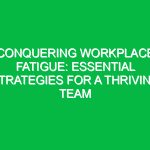Understanding Workplace Health and Safety in the HSE Domain
Workplace health and Safety (WHS) is a critical component of the Health, Safety, and Environment (HSE) domain. It encompasses Regulations, policies, and Procedures designed to ensure the safety and well-being of employees in all types of work environments. In an era where workplace incidents can lead to severe consequences—both for employees and organizations—understanding the nuances of WHS is essential for success. This article aims to uncover essential secrets to unlocking effective workplace health and safety practices that not only comply with regulations but also foster a culture of safety and well-being among employees.
The Importance of Workplace Health and Safety
The relevance of workplace health and safety cannot be overstated. A safe work environment leads to numerous advantages, including:
- Increased employee morale and productivity.
- Reduced costs related to accidents and injuries.
- Enhanced company reputation and employee retention.
- Compliance with legal and regulatory requirements.
The relationship between Workplace Safety and organizational success is profound. Companies that prioritize WHS are more likely to succeed in attracting talent, maintaining operational efficiency, and ultimately achieving their business objectives.
Key Components of Workplace Health and Safety
1. Risk Assessment and Management
One of the foundational aspects of workplace health and safety is the process of risk assessment. This involves identifying potential Hazards that could harm employees, assessing the risks associated with those Hazards, and implementing Control Measures to mitigate them. A practical approach to risk assessment can be broken down into the following steps:
- Identify Hazards: Conduct a thorough examination of the workplace to identify physical, chemical, ergonomic, and psychological hazards.
- Assess Risks: Evaluate the likelihood of incidents occurring and the potential severity of harm.
- Implement Controls: Develop and apply Control Measures to eliminate or reduce risks, such as engineering controls, administrative actions, and Personal Protective Equipment (PPE).
For instance, in a manufacturing setting, a common hazard might be machinery that poses a risk of injury. Implementing machine guards and providing adequate Training on safe Operation can significantly reduce the likelihood of accidents.
2. Training and Education
Educating employees about workplace health and safety practices is vital. Training programs should be tailored to the specific hazards of the workplace and the roles of the employees. Regular safety training sessions can cover topics such as:
- Emergency response and Evacuation Procedures.
- Proper use of Personal Protective Equipment.
- Ergonomics and safe lifting techniques.
Real-life examples illustrate how effective training can save lives. For instance, a construction company that implemented a rigorous safety training program saw a 40% decrease in accidents over two years. This success story underscores the impact of investing in employee education.
3. Safety Culture and Leadership Commitment
A strong safety culture begins at the top. Leadership commitment to workplace health and safety is crucial for fostering an environment where safety is prioritized. Leaders should demonstrate their commitment through:
- Active participation in safety meetings.
- Regular communication about safety goals and achievements.
- Encouraging employee involvement in safety initiatives.
One example of effective leadership in safety comes from a well-known tech company that established a “safety ambassador” program. Employees were selected to represent safety interests within their teams, allowing for a grassroots approach to safety culture. This initiative not only empowered employees but also encouraged open dialogue about safety concerns.
4. Incident Reporting and Investigation
Establishing a robust incident reporting system is essential for continuous improvement in workplace health and safety. Employees should feel encouraged to report incidents, near misses, and unsafe conditions without fear of retribution. The process should include:
- Clear guidelines on how to report incidents.
- A systematic approach to investigating incidents to identify root causes.
- Implementing corrective actions based on investigation findings.
For example, a warehouse implemented an anonymous reporting system that led to the discovery of unsafe practices related to ladder use. By addressing these practices, the warehouse significantly reduced ladder-related incidents.
Regulations and Standards Governing Workplace Health and Safety
Understanding Legal Requirements
Compliance with workplace health and safety regulations is not just a legal obligation; it’s a fundamental aspect of organizational responsibility. Various laws and standards govern WHS, including:
- Occupational Safety and Health Administration (OSHA): In the United States, osha sets and enforces standards to ensure safe working conditions.
- Health and Safety at Work Act 1974: In the UK, this act provides a framework for securing the health, safety, and welfare of employees.
- International Organization for Standardization (ISO) 45001: This international standard specifies requirements for Occupational Health and safety management systems.
Organizations must stay updated on these regulations and ensure compliance to avoid legal penalties and promote overall safety. Regular audits and reviews of safety protocols can help maintain compliance and improve safety practices.
Best Practices for Workplace Health and Safety
1. Continuous Improvement
Workplace health and safety should not be a one-time effort; it requires ongoing commitment and improvement. Implementing a continuous improvement process can help organizations refine their safety practices. This may involve:
- Regularly reviewing and updating safety policies.
- Conducting periodic risk assessments to identify new hazards.
- Soliciting employee feedback on safety practices.
For instance, a healthcare facility that regularly updated its safety protocols based on employee feedback experienced fewer incidents and improved staff satisfaction.
2. Emphasizing Mental Health
While physical safety is often the primary focus, mental health is equally important in the workplace. Organizations should implement programs that promote mental well-being, such as:
- Access to counseling services.
- Stress management workshops.
- Creating a supportive work environment that encourages open discussions about mental health.
A case study from a corporate office revealed that introducing mental health days led to increased productivity and employee satisfaction. This example highlights the importance of addressing both physical and psychological aspects of workplace health and safety.
3. Leveraging Technology
Advancements in technology have transformed workplace health and safety practices. Organizations can utilize various tools and platforms to enhance their safety programs. Examples include:
- Mobile apps for incident reporting and safety checklists.
- Wearable technology that monitors employee health and safety in real-time.
- Virtual reality training programs that simulate hazardous situations.
For instance, a manufacturing company that adopted wearables to monitor exposure to harmful substances was able to significantly reduce incidents related to chemical exposure.
Conclusion
In conclusion, unlocking the secrets to effective workplace health and safety is crucial for organizational success. By prioritizing risk assessment, investing in training, fostering a strong safety culture, and adhering to regulations, organizations can create a safer work environment. The Benefits of a robust workplace health and safety program extend beyond compliance; they include improved employee morale, reduced costs, and enhanced organizational reputation. As businesses navigate the complexities of the modern workplace, a steadfast commitment to health, safety, and environment principles will pave the way for sustainable success. It is time for organizations to reflect on their current practices, embrace continuous improvement, and foster a culture of safety that resonates throughout their workforce.


